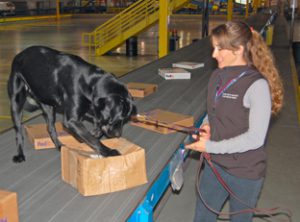
CDFA’s Detector Dog program is among funding recipients.
The U.S. Department of Agriculture (USDA) is allocating $14.8 million to California from Section 10007 of the 2014 Farm Bill as part of its effort to strengthen the nation’s infrastructure for pest detection and surveillance, identification, and threat mitigation, and to safeguard the nursery production system. Overall, USDA is providing nearly $70 million in funding this year that will support 494 projects across the country.
“We are pleased to partner with California to provide critical Farm Bill funds that will put innovative ideas into action and help us overcome our shared invasive pest and disease challenges,” said USDA Under Secretary Greg Ibach. “California is a critical partner in protecting U.S. agriculture. These projects will enable California to protect its own resources, and, in doing so, contribute to USDA’s mission of keeping our nation’s agriculture economy healthy and strong.”
These funds will support projects covering a range of plant health and pest mitigation activities, including the following:
- $4.3 million to survey for harmful exotic fruit fly populations in the State;
- $3.5 million to support the activities of California’s agricultural detector dog teams searching for harmful, exotic plant pests in packages at mail and express parcel delivery facilities;
- $1.8 million to support National Clean Plant Network foundation plant stocks for citrus, grapes, fruit trees, sweet potato, and roses;
- $1.7 million to support California’s Emergency Plant Health Response Teams for responding to, delimiting the infestation area, and managing outbreaks of exotic plant pests;
- $1.3 million for survey activities for plant pests such as Asian defoliator moths, Khapra beetle, and pests harmful to citrus, stone fruit, and palm commodities;
- $1.1 million to develop or enhance plant pest and disease diagnostic and identification technologies for exotic fruit flies, cyst forming nematodes, downy mildew, and others;
- $740,000 to develop best management practices for pest and disease mitigation at ornamental nurseries;
- $260,000 to identify and use predatory insects as biological control tools for the insect pests Bagrada bug and shot hole borer;
- $80,000 to support improvement of Varroa mite resistant commercial honey bee stocks; and
- $9,000 for the development of molecular tools for the detection of gall forming nematodes in the family Anguinidae.
USDA has provided approximately $263 million in Section 10007 funds to support more than 2,200 projects since the 2014 Farm Bill was enacted. Collectively, these projects continue to bolster our country’s safeguarding system while allowing USDA and its partners to quickly detect and rapidly respond to invasive pests and diseases. You can view the FY 2018 spending plans on the USDA Animal and Plant Health Inspection Service (APHIS) Web site at www.aphis.usda.gov/farmbill.
APHIS created the Hungry Pests public outreach program to empower Americans with the knowledge they need to leave these “hungry pests” behind. Visit www.aphis.usda.gov/pestsdiseases/hungrypests to learn more about invasive plant pests and diseases impacting your area and how you can help.


